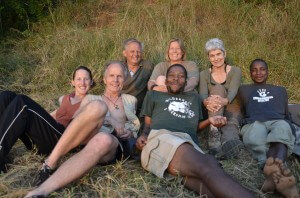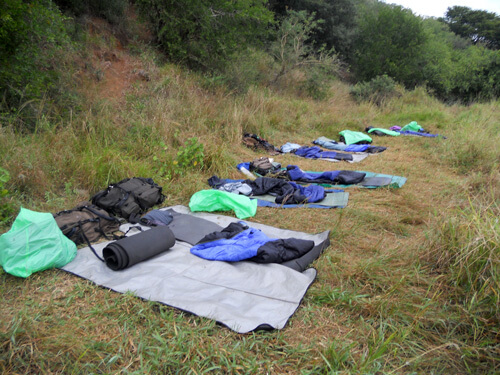Part 3 of our wilderness journey
I have to admit that I was a little nervous about 5 days of backpacking with no tent. Somehow, a tent give me a (perhaps false) sense of safety in the middle of the wilderness. But, I accepted that my trip to Africa was going to push my boundaries a bit, and so I had to chill out. No tent. Just a backpack. Water from the river. Deep breath.
Our guides said “welcome home” each time we arrived at our campsite. The first night, I think this greeting surprised us. We looked around at our ‘camp’ and noticed nothing different from the rest of the trail.
The Wilderness Leadership School practices some of the best leave no trace principles I’ve ever seen implemented. Everyone in our group commented that they learned some new camping tips to take home with them (the only thing aside from photos and memories that we could take from the iMfolozi). Here’s a little review of the leave no trace principles we practiced on trail…
Plan Ahead & Prepare
The WLS has been taking small groups into the iMfolozi since the early 1960s. They have the preparations down to an exact science. Guides go through rigorous training. Group sizes are small. The support staff knows exactly how much food is needed for a 5, 10 or 15 day trip. And, prior to heading on trail, every participant receives a thorough introduction packet, which includes what to bring and what not bring. I was extremely thankful for this pre-trip booklet and read it many times over!
The night before we started our trail, we stayed at the Wilderness Leadership School headquarters. Simphiwe spent the evening with us – answering questions and helping us pack. We each had a ‘kit’ which included a backpack, sleeping bag and mat, plate, spoon and mug and our share of the group’s supplies. As a group, we had 2 cooking pots, 1 tea kettle and a simple tripod to cook over the fire. We needed very little.
Travel & Camp on Durable Surfaces
During the day, we walked only on small paths carved into the landscape by wildlife. At night, we camped in small places, selected by the WLS. Simpewi told us that if a site becomes too rundown, they officially close it and give the area time to restore its natural balance. Nothing is left at these camps – and there is virtually no way to tell if a group had been there even hours before.
Dispose of Waste Properly
Pack in – Pack out is a relatively standard practice. The WLS takes this seriously—we didn’t even pack toilet paper in or out. Instead, we used a nice soft leaf from the ‘toilet paper bush’ anytime we needed it.
Leave What You Find
We took photos, that was all. Everything else remained as it was – no shiny rocks or bottles of sand came home as souvenirs.
Minimize Campfire Impacts
This is perhaps the most intricate campsite practice on trail. Even though our fires were small, there was always a small pile of ashes and a bit of scorched earth. Before leaving camp, the coals were extinguished with a minimal amount of water, then mixed equally with dirt and leaves. The mixture was spread sparsely in the surrounding field or forest. Next, the fire spot was covered with grass, dirt and leaves. Lastly, water was sprinkled over the area. The result….no one could tell where the fire was or even know there was a fire at all!
Respect Wildlife
Vance talked a little about this in his post about wildlife yesterday, I’ll elaborate a bit more. We all commented about how unique it was to experience the African wildlife so personally. We listened to our experienced guides – stopped moving when they told us to, moved quickly at other times. We changed our route if we needed to and stopped to watch only when we weren’t noticed.
We also saw animals respecting each other’s movements. Elephants stay on one side of the river, while buffalo graze on the other side. A wildebeest kept watch for the rhinos. The animals moved slowly and paid attention to what their fellow creatures were doing. We learned by watching.
Be Considerate of Other Visitors
The Wilderness Leadership School is the only organization allowed to take walking guests into the iMfolozi. All other park visitors are required not only to stay on the road but stay in their cars. On the last night, though, we saw the flashlight of another WLS group, scanning their camp during evening watch. We never saw them, but I think that perhaps our guides knew how to be considerate of the other group’s experience and ensure that spent out last day hiking without the distraction of other human visitors.
More than any other camping experience I have had – I felt like I left no trace of my time in the iMfolozi. Perhaps what is even more telling is that when I came back from trail and reunited with my full suitcase, it felt strange to be carrying so much.
 Notes: Our recent wilderness trail experience (30 April – 4 May 2011) included Vance Martin, WILD’s President, Emily Loose, WILD’s Director of Communications, Charlotte Baron, Chair of WILD’s Board of Directors, Magnus and Bettina Sylven, our friends and colleagues from Switzerland and our guides: Mandla and Simphiwe.
Notes: Our recent wilderness trail experience (30 April – 4 May 2011) included Vance Martin, WILD’s President, Emily Loose, WILD’s Director of Communications, Charlotte Baron, Chair of WILD’s Board of Directors, Magnus and Bettina Sylven, our friends and colleagues from Switzerland and our guides: Mandla and Simphiwe.







Go Charlotte and Emily!